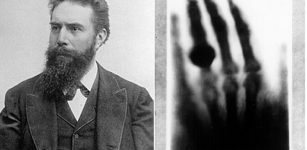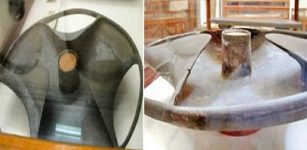Rock-Cut Tombs Of Beni Hasan With Spells, Prayers To Osiris And Anubis And Map To Underworld
A. Sutherland - AncientPages.com - The rock-cut tombs of an ancient Egyptian cemetery, Beni Hasan, were mainly used during the Middle Kingdom, from 21st to 17th century BC.
Entrance to a Tomb at Beni Hassan, David Roberts, 1838. Image credit: David Roberts - Public domain
They were constructed for many powerful nobles and provincial governors of the 11th and 12th dynasties (2125-1795 BC). During the reign of Sesostris III, many local workers decorated them, but later, when Sesostris III's power was reduced mainly, this burial tradition ceased.
There are 39 tombs carved into the limestone hillside south of the modern town of Minya on the east side of the Nile in Middle Egypt. Many have rich interior paintings depicting scenes from everyday life: most of them were robbed many times in antiquity.
However, the well-preserved wall decoration remained untouched until Percy Newberry, British Egyptologist, began meticulously recording every scene on the walls in 1890.
 The tombs were constructed for many powerful nobles and provincial governors of the 11th and 12th dynasties (2125-1795 BC).
The tombs were constructed for many powerful nobles and provincial governors of the 11th and 12th dynasties (2125-1795 BC).
Ten years later, English archaeologist, John Garstang (1876 - 1956), came to Beni Hasan. During his two-year-long work, he unearthed and investigated almost nine hundred vertically-cut shaft tombs belonging to ordinary people who served the nobles.
Of all 39, only four of the tombs (those of Baqet III, Khety, Khnumhotep III, and Amenemhat) are available for visitors. The most impressive of them is that of Khnumhotep III, with a scene depicting the arrival of Asian visitors to Egypt.
Representation of Khety in his tomb (tomb 17). Image credit: Kurohito - CC BY-SA 3.0
The tombs have columned entrances and the walls painted in horizontal registers that run around them. There are scenes with the provision of food, gathering papyrus, fishing and hunting, spinning and weaving, but simple local workers and not artists made the decorations. The figures have long, stick-like limbs that are disproportionate in size, all painted in grey, pink and orange colors.
The ownership of the tombs was recorded on the painted wooden coffins, which contained several burials, perhaps the entire families). The coffins were inscribed with a prayer to Anubis or Osiris and decorated with a pair of eyes. Through the eyes, the deceased could see.
Spells painted on the coffins' inside guaranteed the deceased's passage to the afterlife, and a 'map' to the underworld on the coffin's floor guided the soul on its journey.
Beni Hasan model funerary boat with crew. Image credit: Voluremuseum - CC BY-SA 4.0
Many of the bodies were badly mummified and wrapped quickly in bandages. No investigation confirmed whether the bodies were buried at the same time or added in different periods.
The most curious feature of the tombs was the colorfully painted tiny, wooden models found in every chamber and depicting miniature figures working in granaries, bakeries, different shops, workshops of carpenters, goldsmiths, and other artisans and industries.
Archaeologists also discovered model boats with tiny figurines of wooden sailors and miniature human figures (no more than 15cm (6in) tall and about 7.5cm (3in) in the tombs of the governors. They symbolized 'continuously work' for the deceased in the afterlife.
The most beautiful is the grave of Khnumhotep III, an Ancient Egyptian high steward and vizier of the 12th Dynasty. The tomb's walls are covered with lively and colorful scenes with many themes and Khnumhotep's well-preserved biographical inscription.
Written by – A. Sutherland AncientPages.com Staff Writer
Updated on August 2, 2022
Copyright © AncientPages.com All rights reserved. This material may not be published, broadcast, rewritten or redistributed in whole or part without the express written permission of AncientPages.com
Expand for referencesReferences:
I. Rosellini, F.Serino, The Monuments of Egypt and Nubia
Hobson Ch. Exploring the World of the Pharaohs
Spara
Spara
Spara
Spara
Spara
More From Ancient Pages
-
 Rare Ancient Human Footprints Found On Gower Peninsula, Wales Are 7,000 Years Old
Archaeology | Mar 8, 2017
Rare Ancient Human Footprints Found On Gower Peninsula, Wales Are 7,000 Years Old
Archaeology | Mar 8, 2017 -
 King Khufu’s 4,600-Year-Old Solar Boat Has Been Transported To The Grand Egyptian Museum
Archaeology | Aug 9, 2021
King Khufu’s 4,600-Year-Old Solar Boat Has Been Transported To The Grand Egyptian Museum
Archaeology | Aug 9, 2021 -
 Frightening Edinburgh Vaults: The Spooky Underground City Of The Dead
Featured Stories | Jun 4, 2016
Frightening Edinburgh Vaults: The Spooky Underground City Of The Dead
Featured Stories | Jun 4, 2016 -
 Oldest Golden Jewel In The Caucasus Unearthed In Azerbaijan
Archaeology | Dec 25, 2017
Oldest Golden Jewel In The Caucasus Unearthed In Azerbaijan
Archaeology | Dec 25, 2017 -
 Face Of Egyptian Man Who Lived 35,000 Years Ago Reconstructed
Archaeology | Apr 7, 2023
Face Of Egyptian Man Who Lived 35,000 Years Ago Reconstructed
Archaeology | Apr 7, 2023 -
 Evidence Of Ancient Gigantic Tsunami That Struck Tel Dor Maritime City Mound, Israel
News | Jan 1, 2021
Evidence Of Ancient Gigantic Tsunami That Struck Tel Dor Maritime City Mound, Israel
News | Jan 1, 2021 -
 Mystery Of Hizir – One Of The Most Enigmatic And Extraordinary Ancient People
Featured Stories | Oct 16, 2018
Mystery Of Hizir – One Of The Most Enigmatic And Extraordinary Ancient People
Featured Stories | Oct 16, 2018 -
 Extraordinary Biblical Frescos Uncovered In Domitilla Catacombs
Archaeology | Jun 3, 2017
Extraordinary Biblical Frescos Uncovered In Domitilla Catacombs
Archaeology | Jun 3, 2017 -
 On This Day In History: Discovery Of X-Rays By Wilhelm Roentgen Reported – On Jan 5, 1896
News | Jan 5, 2017
On This Day In History: Discovery Of X-Rays By Wilhelm Roentgen Reported – On Jan 5, 1896
News | Jan 5, 2017 -
 DNA Reveals How The Vikings Changed Scandinavian Migration And Ancestry
Archaeology | Jan 5, 2023
DNA Reveals How The Vikings Changed Scandinavian Migration And Ancestry
Archaeology | Jan 5, 2023 -
 First Peoples Of Japan: Ainu Civilization And Its Unknown Origin
Civilizations | Oct 18, 2014
First Peoples Of Japan: Ainu Civilization And Its Unknown Origin
Civilizations | Oct 18, 2014 -
 Pre-Hispanic Carved Stone Monuments Discovered On A Mountaintop In Puebla, Mexico
Archaeology | Jul 25, 2020
Pre-Hispanic Carved Stone Monuments Discovered On A Mountaintop In Puebla, Mexico
Archaeology | Jul 25, 2020 -
 Different Story Of Odin’s Sons Balder And Hoder In Norse Mythology
Featured Stories | Nov 26, 2020
Different Story Of Odin’s Sons Balder And Hoder In Norse Mythology
Featured Stories | Nov 26, 2020 -
 On This Day In History: Declaration Of Arbroath – The Scots Reaffirm Their Independence – On Apr 6, 1320
News | Apr 6, 2016
On This Day In History: Declaration Of Arbroath – The Scots Reaffirm Their Independence – On Apr 6, 1320
News | Apr 6, 2016 -
 Mysterious Gold-Colored Chariot Washes Ashore In India – But Where Did It Come From?
News | May 12, 2022
Mysterious Gold-Colored Chariot Washes Ashore In India – But Where Did It Come From?
News | May 12, 2022 -
 Schist Disk – Mysterious Piece Of Sophisticated Technology Could Rewrite History – Scientists Are Not Sure What They Are Dealing With
Artifacts | Jun 30, 2013
Schist Disk – Mysterious Piece Of Sophisticated Technology Could Rewrite History – Scientists Are Not Sure What They Are Dealing With
Artifacts | Jun 30, 2013 -
 Llyn Y Dywarchen – Enigmatic Lake Shrouded In Myth And Legend
Featured Stories | Jun 29, 2021
Llyn Y Dywarchen – Enigmatic Lake Shrouded In Myth And Legend
Featured Stories | Jun 29, 2021 -
 Ancient Mystery Of Egypt’s Black Pyramid – Did It Really Exist?
Featured Stories | Nov 28, 2020
Ancient Mystery Of Egypt’s Black Pyramid – Did It Really Exist?
Featured Stories | Nov 28, 2020 -
 Ancient Mystery Of The Man Mound And The Giant With Horns In Wisconsin
Featured Stories | Mar 1, 2021
Ancient Mystery Of The Man Mound And The Giant With Horns In Wisconsin
Featured Stories | Mar 1, 2021 -
 3D Scan Will Uncover Secrets Of The Magnificent Vindelev Gold Treasure
Archaeology | Oct 25, 2023
3D Scan Will Uncover Secrets Of The Magnificent Vindelev Gold Treasure
Archaeology | Oct 25, 2023



